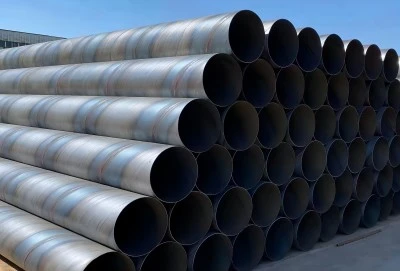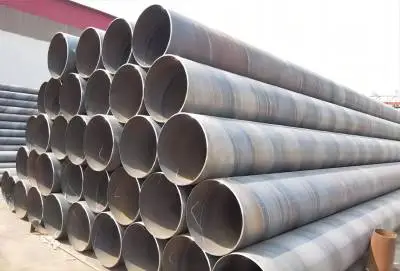1. Introduction:
Spiral welded steel pipe plays a crucial role in a wide range of industrial applications, from oil and gas transportation to water supply and chemical processing. These pipes are manufactured using a specialized process that involves continuously wrapping a steel strip and welding it into a spiral shape. The ability to control the diameter of these pipes is essential in ensuring their proper fit and functionality within various systems and infrastructure.
In this article, we will delve into the process of setting the diameter of spiral welded pipes, exploring the key factors and techniques involved in achieving the desired dimensions. By understanding the intricacies of this process, you can ensure the production of high-quality spiral welded pipes that meet the exacting requirements of your industrial applications.
|
|
|
2. Basic knowledge:
Spiral welded steel pipes are manufactured using a unique process that involves continuously wrapping a steel strip around a mandrel and welding the seam to create a seamless, spiral-shaped pipe. The diameter of the pipe is determined by the width of the steel strip and the angle at which it is wrapped around the mandrel.
The manufacturing process typically involves the following steps:
(1).Steel strip coil is fed into the forming machine.
(2).The steel strip is guided and shaped around a mandrel, forming the desired spiral shape.
(3).The spirally formed steel strip is welded along the seam using a high-frequency welding process.
(4).The welded pipe is then cut to the desired length and undergoes further processing, such as coating or surface treatment, as required.
By understanding the principles of this manufacturing process, you can better appreciate the importance of precise diameter control and the factors that influence it.
3. Diameter setting:
Adjusting the diameter of spiral welded pipe is a crucial step in the manufacturing process, as it ensures the pipes fit seamlessly within the intended applications. To set the desired diameter, you must carefully control the forming machine and its various parameters.
The primary factors that influence the pipe diameter include the width of the steel strip, the angle at which it is wrapped around the mandrel, and the speed of the forming process. By adjusting these parameters, you can achieve the target diameter for your spiral welded pipes.
To set the diameter, start by selecting the appropriate width of the steel strip based on your target pipe size. Next, adjust the angle of the forming machine to control the spiral winding pattern. A steeper angle will result in a smaller diameter, while a shallower angle will produce a larger diameter. Finally, regulate the speed of the forming process to ensure the steel strip is wrapped and welded consistently, maintaining the desired diameter throughout the length of the pipe.
It's important to note that these adjustments must be made in a precise and coordinated manner to achieve the required dimensional accuracy. Careful monitoring and fine-tuning of the forming machine's parameters are essential to producing spiral welded pipes with the correct diameter.
4. Weld gap control:
Maintaining a consistent weld gap is another critical factor in ensuring the accurate diameter of spiral welded pipe. The weld gap refers to the distance between the two edges of the steel strip as they are joined together during the welding process.
If the weld gap is too wide, it can lead to an increase in pipe diameter, potentially causing fit and functionality issues. Conversely, a too-narrow weld gap can result in a smaller pipe diameter and compromised structural integrity.
To control the weld gap, you must carefully adjust the positioning and alignment of the welding equipment in the forming machine. This includes fine-tuning the angle and distance of the welding electrodes, as well as monitoring the weld bead formation to ensure a consistent and uniform seam.
Regular inspection and measurement of the weld gap during the manufacturing process are essential to maintaining the desired pipe diameter. Any deviations from the optimal weld gap should be promptly addressed to ensure the consistent production of spiral welded pipes with the correct dimensions.
5. Dimensional accuracy and quality control:
Achieving and maintaining the dimensional accuracy of spiral welded pipes is crucial to ensuring their proper fit and functionality within various industrial applications. To this end, comprehensive quality control processes must be implemented throughout the manufacturing process.
Regular measurement and inspection of the pipe diameter at various stages of production are essential. This may involve the use of advanced metrology equipment, such as laser-based measurement systems or coordinate measuring machines, to accurately assess the pipe dimensions and identify any variations or deviations from the target specifications.
In addition to dimensional control, other quality control measures may include visual inspections for defects, non-destructive testing to assess weld quality, and destructive testing to evaluate the mechanical properties and performance of the finished pipes. These comprehensive quality assurance measures help to ensure the production of spiral welded pipe that meet the stringent requirements of your industrial applications.
By maintaining a robust quality control program and continuously monitoring the dimensional accuracy of your spiral welded pipes, you can deliver products that reliably and consistently meet the needs of your customers.
6. Spiral Welded Pipe Manufacturers:
Longma, a renowned manufacturer in the steel pipe industry, offers a comprehensive range of spiral welded pipes with a wide variety of outer diameters, from 1/2" to 72". Their state-of-the-art manufacturing facilities and specialized expertise in spiral welding technology enable them to produce high-quality pipes that meet the demanding requirements of various industrial applications.
Longma's commitment to precision and quality control is evident in their stringent manufacturing processes, which include careful adjustment of the forming machine parameters and meticulous monitoring of the weld gap to ensure dimensional accuracy. Their comprehensive quality assurance program, which incorporates both non-destructive and destructive testing, further guarantees the reliability and performance of their spiral welded pipes.
For industries seeking reliable and high-quality spiral welded pipe, Longma invites inquiries at info@longma-group.com. By providing detailed specifications and requirements, Longma's experienced team can assist in selecting the most suitable pipe solutions to meet your project's needs, ensuring a seamless and successful integration into your industrial systems.














